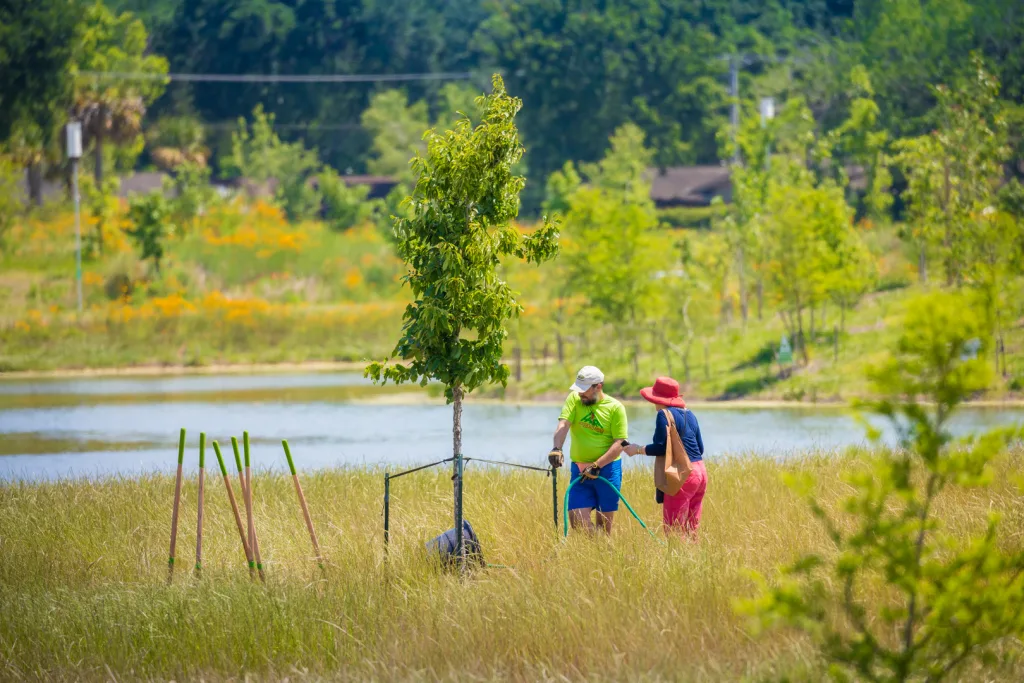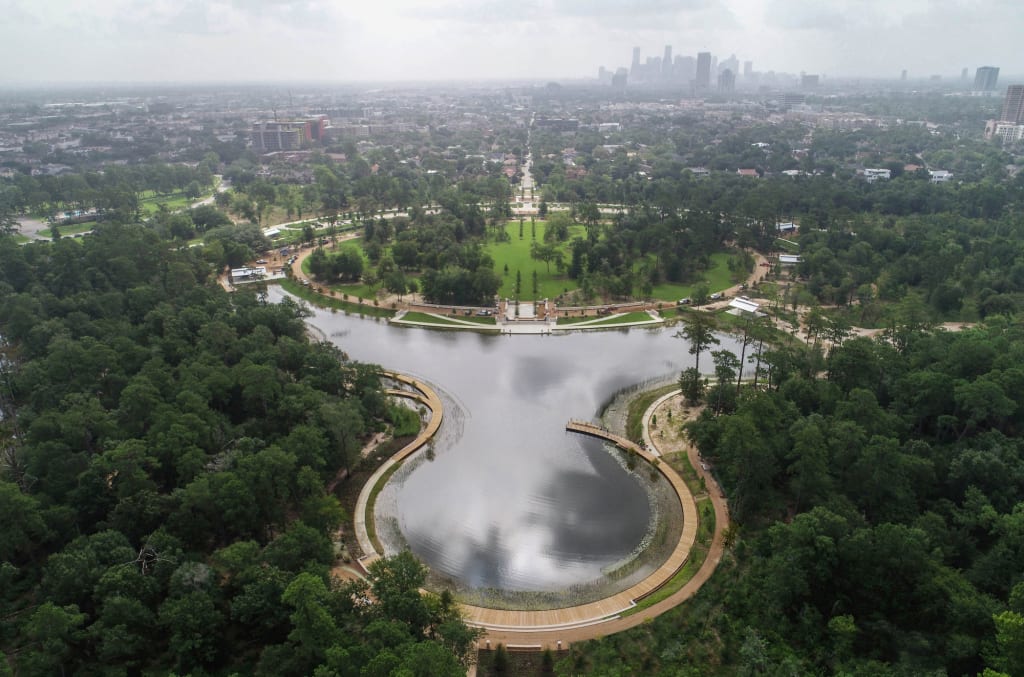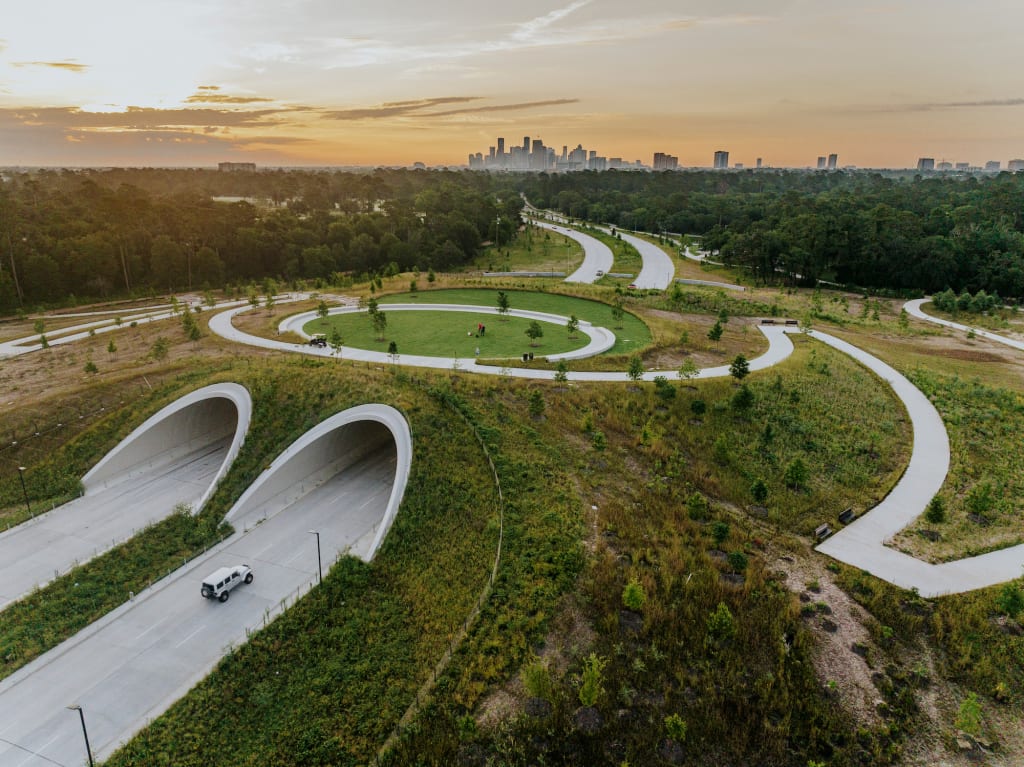When Hurricane Beryl dumped up to a foot of rain on Houston earlier this month, some neighborhoods went underwater. But in a community called Clear Lake on the city’s southeast edge, streets and homes stayed dry.
A former golf course in the neighborhood has been fully redesigned to help store as much as half a billion gallons of rainwater. The 178-acre space completed last year doubles as a local park and wildlife habitat.
In the past, the area regularly flooded, even in fairly minor storms. “I’ve driven my truck through streets that had 12 inches of water in them,” says Thomas Morrow, president of the Clear Lake City Water Authority.
How the park began
Around 20 years ago, the water authority’s board worked with consultants to study the neighborhood’s worsening flooding problem. Experts recommended detention ponds. At the same time, a local golf course had recently closed.
“The golf course had not done well, and it was bought by a third party that claimed it was going to keep the golf course alive,” says Jerry Hamby, who lived in the neighborhood at the time and later became a volunteer for the new park. “There were immediate suspicions that this company had plans to flip it for development.”
Neighbors didn’t want that to happen. The water authority realized that if the golf course were to be paved over for development, flooding in the area would increase, so the agency made an offer on the property. When its offer was rejected, the agency sued for eminent domain. When the purchase was finally able to go through in 2011, the board worked with the community on repurposing plans.
They didn’t want typical stormwater infrastructure. “We have a history in Houston when we deal with flood mitigation to put in these very unattractive detention ponds,” Hamby says. “They might just be fenced off and have sod going down the banks. The community was adamant that they wanted something a little more aesthetically pleasing.”

Former putting greens planted with native grasses, wildflowers, and Texas trees
Working with SWA Architects, the water authority, community, and other partners began planning the park, which is now called Exploration Green. The huge detention ponds are surrounded by walking trails. The former putting greens were replanted with native grasses, wildflowers, and hundreds of trees. Volunteers from the community did most of that work, helping save costs, and still assist in maintaining the park now. The ponds store some water all of the time, helping keep the prairie and wetland plants alive. During heavy storms, the ponds temporarily store the extra water, slowing it down so the nearby streets and bayou don’t flood.

When Hurricane Harvey hit in 2017 and devastated other parts of Houston, the first phase of the project was nearly complete. The water authority decided to remove a dam that was temporarily in place during construction to let rain flow through. The new system worked. “There are houses that sit along the first phase of Exploration Green that almost always flooded in high water,” Morrow says. “About 200 houses that normally flood did not flood.” The fully complete project can protect around 3,000 homes from flooding.

The park has other benefits. Hundreds of species of birds, from herons to bluebirds, now migrate through the area or nest there. Multiples species of butterflies, bats, turtles, cottontail rabbits, and other animals live there. While some other neighborhoods in Houston have to spray for mosquitoes, fish and birds in the park control mosquitoes in Clear Lake. “It’s functioning like a native landscape,” Hamby says.
Houston is embracing nature to mitigate flooding
The project is one example of how Houston is embracing green space and nature to help deal with flooding as climate change makes severe storms more likely. (In Hurricane Harvey, when some parts of Houston got more than 40 inches of rain over four days, climate change made the record rainfall three times more likely and 15% more intense.)

Some projects are going even further to restore native landscape. At Memorial Park—a sprawling park roughly twice as large as New York’s Central Park—a nonprofit transformed a pine forest back to native wetland prairie. The trees, which were originally planted for forestry in the 1800s, had started dying off because of drought. The nonprofit, which took over the park from the city in 2016, originally planned to replant trees, but then realized that wasn’t the best option.
“The entire Gulf Coast was once almost all native Gulf Coast prairie, and there’s less than 1% of that left now,” says Shellye Arnold, president and CEO of the nonprofit, called the Memorial Park Conservancy. “We determined that we needed to re-create what once worked.”
When it rains, millions of gallons of water flow across the park. By replanting native prairie plants, more water can be captured and slowed down in a storm. Over the next decade, other parts of the park will be restored to wetlands and native savanna habitat. Last year, two plant-covered “land bridges” were completed over a highway that runs through the park, connecting green space so that wildlife can easily cross the road.

Houston has a reputation for sprawl, concrete, and freeways. But the city is also beginning to change. “We’re building a tremendous amount of green infrastructure over the city,” Arnold says. Since Hurricane Harvey, the government has bought out hundreds of homes that have repeatedly flooded so residents can relocate. Extra green space where the houses once sat can help absorb more rain. The city, which is filled with bayous and development, still faces major challenges from flooding. But bringing back more nature is a step in the right direction.
